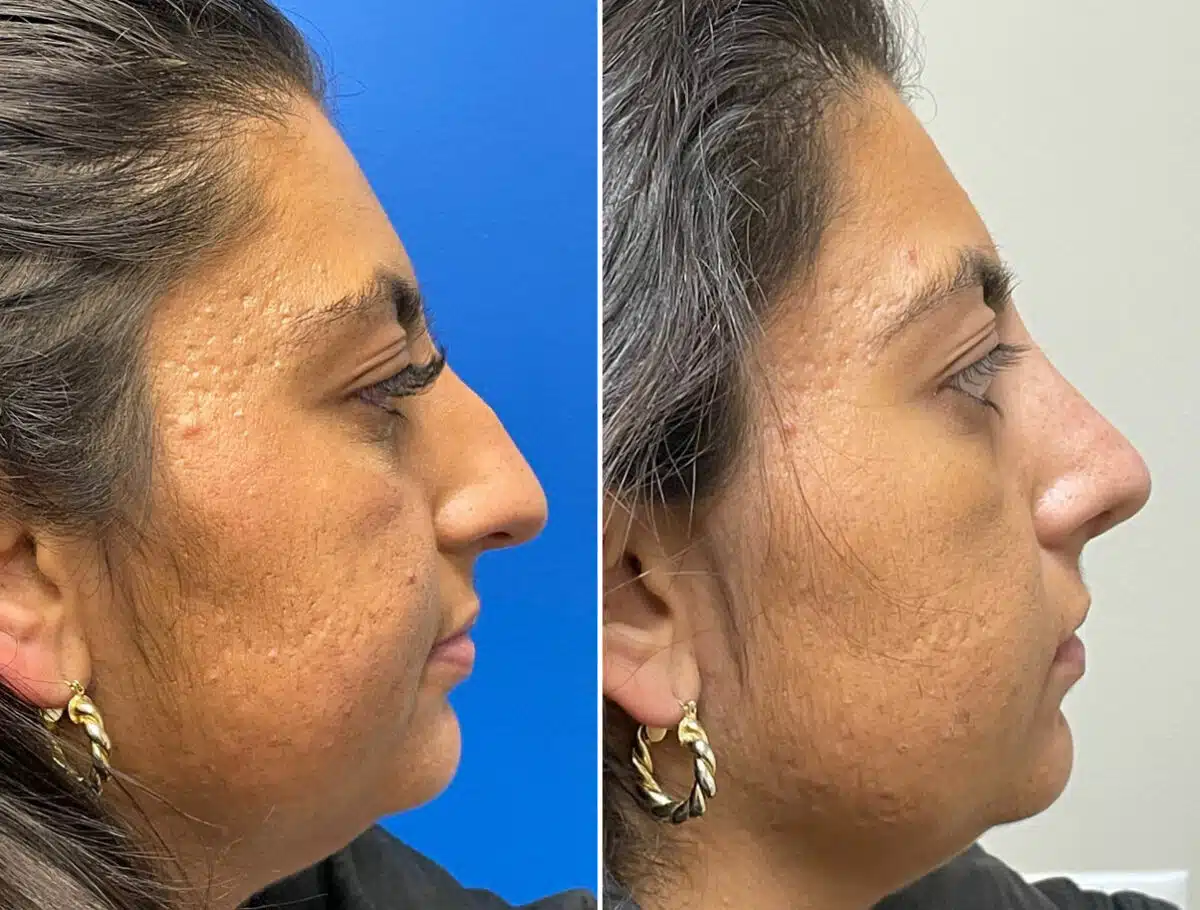Pollybeak Deformity After Rhinoplasty

Have you noticed a subtle bulge forming on the bridge of your nose after a rhinoplasty operation? This common concern among rhinoplasty patients may be more than just residual swelling—it could be a pollybeak deformity, a nasal deformity that affects the contour of the nose and your overall facial harmony.
Pollybeak deformity can interfere with the creation of a balanced, pleasing nose shape and often leaves patients frustrated after putting so much trust into their initial surgery. If you’re looking to understand what’s happening and what can be done, you’re in the right place. Let’s explore what this is all about—and how you can fix it.
What is a Pollybeak Deformity?
A pollybeak deformity is a nasal deformity that occurs when the area just above the nasal tip—called the supratip—protrudes outward, giving the side profile a parrot-beak appearance. This look typically results from issues during a rhinoplasty operation and may give the illusion that a dorsal hump has returned, even if it was removed during the initial surgery. Rather than a smooth contour, the nasal structure takes on a fuller or drooping form in the supratip region, which disrupts the desired aesthetic line of the nose.
What Causes a Polly-beak Deformity?
A pollybeak deformity can result from several factors related to the healing process or missteps during nose surgery. One common cause is the under-resection of the nasal tip cartilage, where too much cartilage remains and pushes the tip upward, creating a beak-like appearance. Another frequent issue involves excessive scar tissue buildup in the supratip area, especially in patients with thick skin or poor healing responses. This buildup can distort the natural slope of the nasal bridge, leading to an unnatural profile.
In some cases, over-reduction of the lateral cartilage or insufficient support to the nasal tip can cause collapse or drooping that mimics or contributes to the deformity. The choice of surgical techniques also plays a significant role—if the structural balance of the nose isn’t preserved during the procedure, it may predispose the area to deformities as it heals. Recognizing these causes is the first step in planning an effective correction strategy.
How Do I Tell if It’s a Polly-beak Nose Deformity or Just Swelling?
In the early stages of healing, especially within the first few months after rhinoplasty, swelling can closely mimic the appearance of a pollybeak deformity. However, swelling tends to feel soft, changes throughout the day, and gradually improves over time. In contrast, a true pollybeak deformity feels firmer and more persistent, especially in the supratip area.
If you’re more than six months post-op and still noticing a consistent fullness above the nasal tip that disrupts the nasal profile, it’s worth having a specialist examine it. A physical exam and possibly imaging can help distinguish between lingering swelling and a structural deformity that may require revision.
Types of Pollybeak Deformity
Not all pollybeak deformities are the same—understanding the type you’re dealing with is crucial for selecting the most effective treatment. These deformities are generally categorized based on what causes the supratip fullness: excess cartilage or soft tissue. In this section, we’ll explore the two main types of pollybeak deformity to help you identify the one that might apply to your situation.
Cartilaginous Pollybeak
A cartilaginous pollybeak deformity occurs when too much cartilage is left behind during the initial rhinoplasty, particularly in the area of the septum or the lower lateral cartilages. This excess cartilage creates a prominent bulge in the supratip region, pushing the nasal tip downward and producing the classic parrot-beak shape. Patients with strong nasal tip cartilage or those who received minimal cartilage reduction are more prone to this type of deformity. Precise structural planning and surgical refinement are necessary to prevent or correct this cartilage-based issue.
Soft Tissue Pollybeak Deformity
This type of deformity is caused not by cartilage, but by an excess of soft tissue—often in the form of thick nasal skin or scar tissue that accumulates in the supratip area. It’s more common in patients with naturally thicker skin or in those whose skin doesn’t contract evenly after surgery. Unlike cartilaginous deformities, this condition can take longer to become apparent, as swelling and tissue buildup gradually distort the nasal profile. Treatment may focus more on managing the soft tissue rather than structural revision.
Secure Your Safe Treatment Experience with Dr. Daniel G. Becker.
Join our satisfied clients who’ve experienced safe, effective treatments.
Pollybeak Deformity Correction Techniques
Correcting a pollybeak deformity involves more than just refining the nose’s appearance—it requires an expert understanding of nasal anatomy, healing patterns, and previous surgical outcomes. In many cases, revision procedures must be customized based on the type and severity of the deformity, as well as the patient’s unique tissue characteristics. Whether caused by cartilage excess or soft tissue buildup, modern facial plastic surgery offers a variety of methods to help restore nasal balance and aesthetic harmony.
Steroid Injections
Steroid injections are often the first line of treatment for a soft tissue pollybeak deformity. These injections help reduce inflammation and break down excess scar tissue in the supratip area, gradually smoothing the contour of the nasal bridge. They are especially effective within the first year after surgery, when tissue remodeling is still active. While not suitable for every case, steroid injections offer a non-surgical option for patients experiencing minor fullness or swelling that mimics the appearance of a pollybeak deformity.
Dermal Fillers
For patients with mild to moderate deformities who prefer a non-surgical treatment option, dermal fillers can offer a temporary yet effective solution. In a procedure sometimes referred to as a non-surgical nose job, carefully placed fillers can smooth the contour of the supratip area and disguise the bulge created by a pollybeak deformity. While this method doesn’t remove the underlying issue, it provides immediate cosmetic improvement with minimal downtime. It’s often used as a short-term fix or diagnostic tool before committing to revision surgery.
Revision Rhinoplasty Surgery
When non-invasive methods aren’t enough, a secondary rhinoplasty procedure—commonly referred to as revision surgery—is often the most definitive way to correct a pollybeak deformity. This form of corrective surgery is more complex than a primary rhinoplasty and requires careful evaluation of what went wrong during the previous rhinoplasty. The surgeon must navigate scar tissue, altered anatomy, and patient expectations to deliver a better outcome.
In many cases, structural support must be rebuilt using cartilage grafts, often harvested from the patient’s ear or rib. These grafts help restore balance and projection to the nasal tip while smoothing out the supratip area. Because of the technical difficulty involved, revision rhinoplasty should always be performed by a specialist with extensive experience in reconstructive nasal procedures.
Consult With an Expert Nose Surgeon Today
Correcting nose imperfections and nasal deformities requires not only precision but also an advanced understanding of nasal anatomy. Because a pollybeak deformity can result from multiple factors—be it excess cartilage, scar tissue, or technical missteps—it’s essential to work with a facial plastic surgeon who specializes in revision rhinoplasty and who can restore both form and function to your nose.
Dr. Daniel Becker, founder of the Becker Rhinoplasty Center, is a nationally recognized rhinoplasty specialist and Clinical Professor at the University of Pennsylvania. With over 100 scientific publications, four surgical textbooks, and decades of experience correcting complex nasal issues, he is trusted by rhinoplasty patients nationwide. Call us today at 856-772-1617 or 856-589-6673, or visit our contact page to schedule your consultation.

